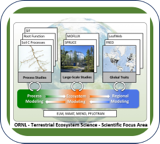Compositional stability of peat in ecosystem-scale warming mesocosms
| Author | |
|---|---|
| Keywords | |
| Abstract |
Peatlands historically have acted as a C sink because C-fixation rates exceeded the rate of heterotrophic decomposition. Under future warmer conditions predicted for higher latitudes, however, that balance may shift towards higher rates of heterotrophic respiration leading to the release of previously stored C as CO2 and CH4. The Spruce and Peatlands Response Under Changing Environments (SPRUCE) experiment is designed to test the response of peatlands to climate forcing using a series of warmed enclosures in combination with peat below-ground heating from 0 to +9°C above ambient conditions. This experimental design allowed a test of chemical changes occurring within peatland soils following five years of warming. We analyzed samples in the uppermost 2m of peat using Fourier Transform Infrared Spectroscopy (FT-IR) to quantify the relative abundance of carbohydrate and aromatic compounds in the peat. The peat soils were subjected to deep peat heating (DPH) beginning in June of 2014 followed by whole ecosystem warming (WEW) in August of 2015. We found that the relative amounts of labile and recalcitrant chemical compound groups across the full peat depth interval did not significantly change after five years of exposure to warming. This appears the case even though previous studies have shown that net C losses and loss of bulk peat mass to be instability over that time period. Results suggest that the current store of carbon in peatlands are largely compositionally stable leading to no changes the in the ratio of chemical moieties on the initial four-year timescale of this experiment. |
| Year of Publication |
2022
|
| Journal |
PLOS ONE
|
| Volume |
17
|
| Issue |
3
|
| Number of Pages |
e0263994
|
| ISSN Number |
1932-6203
|
| DOI |
10.1371/journal.pone.0263994
|
| Download citation |

